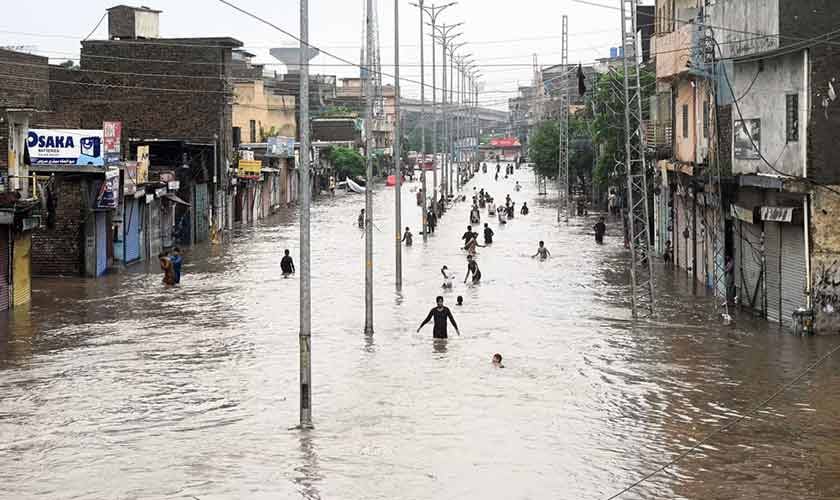
#Economic #impact #flood #devastation #Political #Economy
In recent years, especially since 2022, tens of billions of dollars have been caused by the loss, destroying hundreds of thousands of homes, and wiped out major areas of fields and livestock.
These floods have also severely damaged transportation, water, education and health infrastructure. Some specialist diagnosis has directly damaged the $ 15 billion economic losses in the 2022 event, as well as $ 15 billion. Other studies indicate high stability estimates (when indirect effects and prolonged disadvantages are added – up to 0-40 billion). Since 2022, the flood style has added fresh local losses every year, with the heavy burden of agricultural sector and rural housing.
AfFECED Population
The flood of 2022 affected about 33 33 million people and displaced about 8 million, which is one of the largest climate disasters in recent memories. Millions of people need immediate humanitarian assistance.
2022 studies destroyed 897,014 houses and damaged another 1,391,467. In 2023-2024, floods added tens of thousands of more damaged or destroyed houses in different provinces.
Infrastructure
Road and Bridge networks suffered a scale – 13,115 km of roads and 439 bridges were affected or destroyed in the 2022 event. Schools, health facilities and water systems were also greatly damaged. UNICEF and other agencies only damaged or destroyed 30,000 schools and 2,000 health services in the 2022 event.
Agriculture And Cattle
Agricultural losses were “extraordinary”. During 2022, more than 1.16 million livestock were killed, more than thousands of acres of crops were submerged or lost, and critical cash crops (cotton, rice, sugarcane, corn) were affected in the provinces. In 2024-2025, heavy rains continued to eliminate the crop area and accelerate the food protection pressure.
Financial accounting
Different organizations use different methods: (a) damage – the cost of damaged physical assets; (B) Economic Disadvantages – During the event/ then production/ revenue was wasted. And (C) Reconstruction Requirements – Investing for maintenance and “improve”.
The World Bank needs to be diagnosed after destruction, which is estimated that a total of $ 14.9 billion and economic loss are $ 15.2 billion, leaving common losses + $ 30 + billion. Once some long -term effects have gathered. Reconstruction requirements for the maintenance and construction of climate flexible systems were estimated .3 16.3 billion.
Government And Other studies
Some official documents have described the $ 30 billion data as a total cost of a 2022 flood. In some research groups and media analysis, using alternative diagnosis and prolonged damage estimates, overall losses of up to $ 40 billion were suggested when indirect and economic implications (lost growth, loan service increase, reduction in revenue, health/education smoke).
STUDS STATE (2023– from.2025)
Although none of the single year’s follow -up is similar to the sinking scale across the country, the annual monsoon episodes (2023, 2024 and localized 2025 events) have caused huge losses. 2024 Monsoon reporting shows that tens of thousands of houses and thousands of kilometers of roads were damaged. The estimates of 2025 indicate the disadvantages of the crops, which can reach 2.5 million acres of land. These frequent shocks mix the initial major damage and increase the overall costs.
About 1 million damaged houses are largely costing or repairing. Even the construction of conservative per unit (which is different in terms of the region, from low -cost rural houses to high -cost urban homes), the overall residential bill goes for billions of dollars, the domestic assets, savings and informal sector businesses are destroyed along with houses.
Agriculture was the biggest loss driver: Climate production of standing crops, seed reserves and irrigation damage. The loss of only 1.16 million cattle has reduced domestic capital for rural families and future income decreased in the coming seasons. Disadvantages to cash crops and rabi/ kharif season barriers increased import requirements for food and feed, by pressing financial and external accounts.
Thousands of kilometers of rural roads and several bridges eliminated access to the market. This not only increases the immediate repair bills, but the ongoing expenses of transactions are also underway on traders and farmers (high transport costs, damage).
Thousands of kilometers of rural roads and several bridges eliminated access to the market. This not only increases the immediate repair bills, but the ongoing expenses of transactions are also underway on traders and farmers (high transport costs, damage). Disadvantaged transport links increase the efficient cost of recovery and reduce the pace at which production reaches markets, targeting revenue and tax revenue simultaneously.
The loss of tens of thousands of schools and thousands of health centers is disrupted in prolonged service. Economic Impacts include the lack of school education (future human capital loss), water -producing diseases (health costs and productivity losses) more disease burden and immediate cost of providing and reconstruction of temporary services.
Instant financial load
The central and provincial governments had to re -highlight the budget resources for relief and reconstruction. There was tension on Pakistan’s debt and financial support position-the country sought bilateral, multilateral and donor assistance and re-budget, which increased the budget deficit in the short term. International aid included only a portion of the requirements, which forced the government to increase the borrowing.
Growth And Poverty
The PDNA and its subsequent analysis affected the growth of GDP in the financial years as production and services have been contracted in the flood -affected sectors. The poorest families suffered deep shocks, which increased the heads of poverty and changed some of the benefits of poverty reduction.
Climate change
Scientific analysis and expert commentary attributes have increased the frequency and warmth has increased the intensity of rainfall. Pakistan’s 2022 floods were strictly increased due to climate change in monsoon dynamics. Repeated monsoon (2023-2025 episodes) shows high baseline risk. Similarly, failure to “improve” (flexible infrastructure, flood field management, initial warning and drainage system) will mean repeated financial shocks.
The government needs to take several steps to reduce OSSes due to repeated floods. This includes:
Prefer flexible reconstruction. Use PDNA-style studies to target funds where “improve” will reduce future losses-elastic residential design, rural roads, climate irrigation and flood flexible bridges. Reconstruction requirements were estimated at $ 16 billion (2022 PDNA) – the costs should be strategic to reduce repeated costs in the future.
Protect livelihood and agricultural rehabilitation. Emergency seeds and input distributions, livestock transformation programs and work schemes for work help restore production and reduce long -term poverty nets. Agricultural insurance and disaster risk finance tools (autonomous risk pool, emergency credit lines) should be considered.
Instant health, washing and recovery of education. The water system, clinics and schools are effective at the cost of restoration: It prevents the spread of the disease and reduces long -term human capital losses by UNICEF/ partners.
Strengthen the initial warning and the Basin Management River. Investing in meteorological forecasts, dam/ back management and integrated water shedding measures reduces flood peaks. This can take advantage of international climate financing.
Financial planning and donor coordination. Maximum rehabilitation effects and debt pressure to limit transparent purchases and anti -corruption safety measures, blending grants, privileged loans and domestic resources. PDNA -style coordination with multilateral partners is important.
The “recent flood” in Pakistan-which is dominated by the destruction of 2022 and then has damaged the monsoon events in the years after that-a multi-dimensional shock created: a huge instant bill through destroyed assets (buildings, roads, bridges), with a huge agricultural and a loss of loss from the future. The government and internationally endorsed estimates directly damages and short-term economic losses are within $ 15-30 billion, with reconstruction needs (restoring the economy and providing climate evidence) in tens of billions when multilateral overall impact.
The financial burden is combined with households (loss of assets and economics), firms (lost output and damaged infrastructure) and state (relief, reconstruction, and additional borrowing service). Without stabilizing decisive, flexible reconstruction and destruction, whenever he swings extreme monsoon, Pakistan is repeatedly facing financial and social shock.
Author is a senior economic reporter






